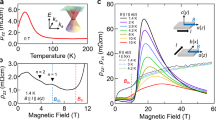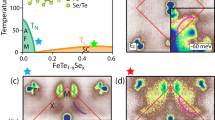Abstract
At the interface between two distinct materials, desirable properties, such as superconductivity, can be greatly enhanced1, or entirely new functionalities may emerge2. Similar to in artificially engineered heterostructures, clean functional interfaces alternatively exist in electronically textured bulk materials. Electronic textures emerge spontaneously due to competing atomic-scale interactions3, the control of which would enable a top-down approach for designing tunable intrinsic heterostructures. This is particularly attractive for correlated electron materials, where spontaneous heterostructures strongly affect the interplay between charge and spin degrees of freedom4. Here we report high-resolution neutron spectroscopy on the prototypical strongly correlated metal CeRhIn5, revealing competition between magnetic frustration and easy-axis anisotropy—a well-established mechanism for generating spontaneous superstructures5. Because the observed easy-axis anisotropy is field-induced and anomalously large, it can be controlled efficiently with small magnetic fields. The resulting field-controlled magnetic superstructure is closely tied to the formation of superconducting6 and electronic nematic textures7 in CeRhIn5, suggesting that in situ tunable heterostructures can be realized in correlated electron materials.
This is a preview of subscription content, access via your institution
Access options
Access Nature and 54 other Nature Portfolio journals
Get Nature+, our best-value online-access subscription
$29.99 / 30 days
cancel any time
Subscribe to this journal
Receive 12 print issues and online access
$209.00 per year
only $17.42 per issue
Buy this article
- Purchase on Springer Link
- Instant access to full article PDF
Prices may be subject to local taxes which are calculated during checkout




Similar content being viewed by others
References
Ge, J.-F. et al. Superconductivity above 100 K in single-layer FeSe films on doped SrTiO3. Nat. Mater. 14, 285–289 (2014).
Reyren, N. et al. Superconducting interfaces between insulating oxides. Science 317, 1196–1199 (2007).
Mohottala, H. E. et al. Phase separation in superoxygenated La2–xSr x CuO4+y. Nat. Mater. 5, 377–382 (2006).
Dagotto, E. Complexity in strongly correlated electronic systems. Science 309, 257–262 (2005).
Selke, W. The ANNNI model—Theoretical analysis and experimental application. Phys. Rep. 170, 213–364 (1988).
Park, T. et al. Textured superconducting phase in the heavy fermion CeRhIn5. Phys. Rev. Lett. 108, 077003 (2012).
Ronning, F. et al. Electronic in-plane symmetry breaking at field-tuned quantum criticality in CeRhIn5. Nature 548, 313–317 (2017).
Boschker, H. & Mannhart, J. Quantum-matter heterostructures. Annu. Rev. Condens. Matter Phys. 8, 145–164 (2017).
Alferov, Z. I. The history and future of semiconductor heterostructures. Semiconductors 32, 1–14 (1998).
Park, T. et al. Hidden magnetism and quantum criticality in the heavy fermion superconductor CeRhIn5. Nature 440, 65–68 (2006).
Moll, P. J. W. et al. Field-induced density wave in the heavy-fermion compound CeRhIn5. Nat. Commun. 6, 6663 (2015).
Das, P. et al. Magnitude of the magnetic exchange interaction in the heavy-fermion antiferromagnet CeRhIn5. Phys. Rev. Lett. 113, 246403 (2014).
Fobes, D. M. et al. Low temperature magnetic structure of CeRhIn5 by neutron diffraction using absoption optimized samples. J. Phys. Condens. Matter 29, 17LT01 (2017).
Raymond, S., Ressouche, E., Knebel, G., Aoki, D. & Flouquet, J. Magnetic structure of CeRhIn5 under magnetic field. J. Phys. Condens. Matter 19, 242204 (2007).
Knebel, G. et al. Antiferromagnetism and superconductivity in CeRhIn5. J. Phys. Soc. Jpn 80, SA001 (2011).
Aso, N. et al. Switching of magnetic ordering in CeRhIn5 under hydrostatic pressure. J. Phys. Soc. Jpn 78, 073703 (2009).
Jiao, L.et al Fermi surface reconstruction and multiple quantum phase transitions in the antiferromagnet CeRhIn5. Proc. Natl Acad. Sci. USA 112, 673–678 2015).
Shishido, H., Settai, R., Harima, H. & Onuki, Y. A drastic change of the Fermi surface at a critical pressure in CeRhIn5: dHvA study under pressure. J. Phys. Soc. Jpn 74, 1103–1106 (2005).
Willers, T.et al Correlation between ground state and orbital anisotropy in heavy fermion materials. Proc. Natl Acad. Sci. USA 112, 2384–2388 2015).
Fak, B. et al. Anomalous spin response in the non-centrosymmetric metal CePt3Si. J. Phys. Soc. Jpn 83, 063703 (2014).
Moll, P. J. W. et al. Emergent magnetic anisotropy in the cubic heavy-fermion metal CeIn3. npj Quantum Mater. 2, 46 (2017).
Borzi, R. A. et al. Formation of a nematic fluid at high fields in Sr3Ru2O7. Science 315, 214–217 (2007).
Chuang, T. M. et al. Nematic electronic structure in the 'parent' state of the iron-based superconductor Ca(Fe1-xCox)(2)As2. Science 327, 181–184 (2010).
Kivelson, S. A., Fradkin, E. & Emery, V. J. Electronic liquid-crystal phases of a doped Mott insulator. Nature 393, 550–553 (1998).
Kitagawa, K., Mezaki, Y., Matsubayashi, K., Uwatoko, Y. & Takigawa, M. Crossover from commensurate to incommensurate antiferromagnetism in stoichiometric NaFeAs revealed by single-crystal 23Na,75As-NMR experiments. J. Phys. Soc. Jpn 80, 033705 (2011).
Raymond, S. & Lapertot, G. Ising incommensurate spin resonance of CeCoIn5: A dynamical precursor of the Q phase. Phys. Rev. Lett. 115, 037001 (2015).
Tranquada, J. M. et al. Evidence for an incommensurate magnetic resonance in La2–xSr x CuO4. Phys. Rev. B 69, 174507 (2004).
Wen, J. et al. Short-range incommensurate magnetic order near the superconducting phase boundary in Fe1+dTe1–xSe x . Phys. Rev. B 80, 104506 (2009).
Baek, S. H. et al. Orbital-driven nematicity in FeSe. Nat. Mater. 14, 210–214 (2015).
Glasbrenner, J. K. et al. Effect of magnetic frustration on nematicity and superconductivity in iron chalcogenides. Nat. Phys. 11, 953–958 (2015).
Ehlers, G., Podlesnyak, A. A., Niedziela, J., Iverson, E. B. & Sokol, P. E. The new cold neutron chopper spectrometer at the Spallation Neutron Source: design and performance. Rev. Sci. Instrum. 82, 085108 (2011).
Bewley, R. I., Taylor, J. W., & Bennington, S. M. LET, a cold neutron multi-disk chopper spectrometer at ISIS. Nucl. Instrum. Methods Phys. Res. A 637, 128–134 (2011).
Suwa, H. & Todo, S. Markov chain Monte Carlo method without detailed balance. Phys. Rev. Lett. 105, 120603 (2010).
Acknowledgements
We acknowledge useful discussions with R. Baumbach, C. Pfleiderer, M. Garst, M. Votja, P. Böni and J. M. Lawrence. Work at Los Alamos National Laboratory (LANL) was performed under the auspices of the US Department of Energy. LANL is operated by Los Alamos National Security for the National Nuclear Security Administration of DOE under contract DE-AC52-06NA25396. Research supported by the US Department of Energy, Office of Basic Energy Sciences, Division of Materials Sciences and Engineering under the project ‘Complex Electronic Materials’ (material synthesis and characterization) and the LANL Directed Research and Development program (neutron scattering, development of the spin wave model, mean-field computation and development of analysis software). Research conducted at Oak Ridge National Laboratory’s (ORNL) Spallation Neutron Source was sponsored by the Scientific User Facilities Division, Office of Basic Energy Sciences, US Department of Energy. Experiments at the ISIS Pulsed Neutron and Muon Source were supported by a beam time allocation from the Science and Technology Facilities Council. We acknowledge the support of the National Institute of Standards and Technology, US Department of Commerce, in providing the neutron research facilities used in this work.
Author information
Authors and Affiliations
Contributions
N.J.G., P.D. and E.D.B. synthesized the single crystal samples; J.D.T. and F.R. carried out thermal and transport measurements; D.M.F., G.E., A.P., L.W.H., R.I.B., V.H., A.S. and M.J. performed the neutron spectroscopy measurements; D.M.F. wrote the software for analysing the neutron data; DMF and MJ analyzed the neutron data; M.J. supervised the experimental work; S.Z., S.Z.L. and C.D.B. developed the theoretical model and carried out all calculations; D.M.F., S.Z.L., C.D.B. and M.J. proposed and designed this study, and D.M.F., C.D.B. and M.J. wrote the manuscript; all authors discussed the data and commented on the manuscript.
Corresponding author
Ethics declarations
Competing interests
The authors declare no competing financial interests.
Additional information
Publisher’s note: Springer Nature remains neutral with regard to jurisdictional claims in published maps and institutional affiliations.
Supplementary information
Supplementary Information
4 Figures, 14 References
Rights and permissions
About this article
Cite this article
Fobes, D.M., Zhang, S., Lin, SZ. et al. Tunable emergent heterostructures in a prototypical correlated metal. Nature Phys 14, 456–460 (2018). https://doi.org/10.1038/s41567-018-0060-9
Received:
Accepted:
Published:
Issue Date:
DOI: https://doi.org/10.1038/s41567-018-0060-9
This article is cited by
-
Single-domain stripe order in a high-temperature superconductor
Communications Physics (2022)
-
Multipole polaron in the devil’s staircase of CeSb
Nature Materials (2022)
-
Kondo quasiparticle dynamics observed by resonant inelastic x-ray scattering
Nature Communications (2022)
-
Spin-texture-driven electrical transport in multi-Q antiferromagnets
Communications Physics (2021)
-
Non-monotonic pressure dependence of high-field nematicity and magnetism in CeRhIn5
Nature Communications (2020)



